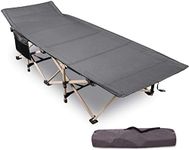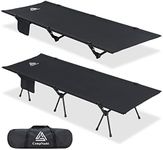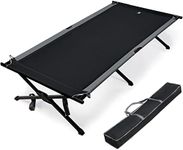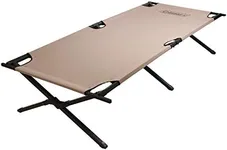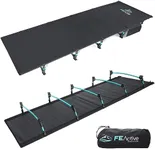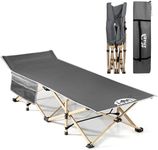Buying Guide for the Best Backpacking Cot
Choosing the right backpacking cot can make a big difference in your comfort and quality of sleep while camping or hiking. The ideal cot should balance comfort, weight, and packability, fitting your personal needs and the type of trips you plan to take. Before making a decision, think about how far you'll be carrying it, the conditions you'll use it in, and how much space you have in your backpack. Understanding the key features will help you find a cot that keeps you well-rested without weighing you down.WeightWeight refers to how heavy the cot is when packed. This is important because every extra pound can make a big difference when you're carrying your gear over long distances. Backpacking cots generally range from ultralight (under 3 pounds) to heavier options (up to 6 pounds or more). Ultralight cots are best for long hikes or trips where every ounce counts, while heavier cots may offer more comfort but are better suited for shorter hikes or car camping. Consider how much weight you are willing to carry and match the cot's weight to your typical trip length and style.
Packed SizePacked size is how small the cot becomes when folded and stored in its carrying bag. This matters because space in your backpack is limited, and a bulky cot can take up valuable room. Cots with a compact packed size (about the size of a water bottle or small tent) are ideal for backpackers who need to maximize space. Larger packed sizes may be acceptable if you have a bigger pack or are not traveling far. Think about your backpack's capacity and how much space you can dedicate to a cot.
Setup and BreakdownSetup and breakdown describe how easy and quick it is to assemble and disassemble the cot. This is important because after a long day of hiking, you want a cot that is simple to put together without frustration. Some cots use simple snap-together frames, while others may have more complex systems. Quick and tool-free setups are best for most backpackers, especially if you expect to be tired or setting up in low light. If you value convenience, look for cots with straightforward assembly.
Comfort and SupportComfort and support refer to how well the cot keeps you off the ground and provides a good night's sleep. This depends on the cot's height, fabric tension, and overall design. Lower cots (closer to the ground) are lighter and more compact but may feel less cushioned, while higher cots offer more support but are bulkier. If you are a side sleeper or have back issues, you may want a cot with more support. Consider your sleeping preferences and any physical needs when choosing the level of comfort.
Durability and MaterialsDurability and materials describe how well the cot holds up to repeated use and rough conditions. Most cots use aluminum frames for lightness and strong synthetic fabrics for the sleeping surface. Higher-denier fabrics and sturdy frames last longer but may add weight. If you plan to use your cot frequently or in rugged environments, prioritize durability. For occasional or fair-weather use, lighter materials may be sufficient.
Weight CapacityWeight capacity is the maximum weight the cot can safely support. This is important for safety and comfort, as exceeding the limit can damage the cot or cause it to collapse. Cots typically support between 250 and 350 pounds, but some heavy-duty models can handle more. Choose a cot with a weight capacity that comfortably exceeds your body weight, especially if you move around a lot in your sleep or plan to use the cot for extended periods.
